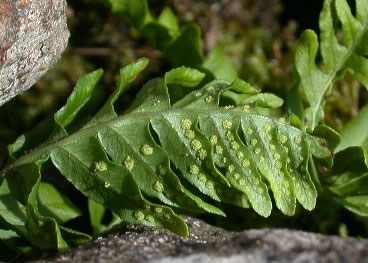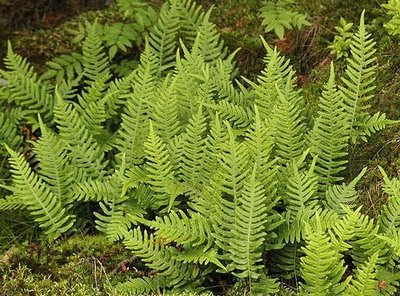Polypodium vulgare (Polypody)

Common name: Polypody
Scientific Name: Polypodium vulgare
Scientific Classification
Kingdom Plantae
Division Pteridophyta
Class Pteridopsida
Order Polypodiales
Family: Polypodiaceae
Genus: Polypodium

Polypody can often be seen growing along the branches of oak trees or even on old roofs. Its dark green fronds are deeply lobed and give the appearance of a double-sided comb. It makes good ground cover and other than being a bit susceptible to drought, which will usually only fry off the foliage and not kill the plant, it is very tough and adaptable.
Polypodium is a large genus of true ferns, widely distributed throughout the world, but specially developed in the tropics. The name is derived from Gr. poly, many, and podium, a little foot, on account of the foot-like appearance of the rhizome and its branches.
The species differ greatly in size and general appearance and in the character of the frond; the son or groups of spore-cases (sporangia) are borne on the back of the leaf, are globose and naked, that is, are not covered with a membrane (indusium). The common polypody (Plypodium vulgare) is widely diffused in the British Isles, where it is found on walls, banks, trees, and other places; the creeping, densely-scaly rootstock bears deeply pinnately cut fronds, the fertile ones bearing on the back the bright yellow naked groups of sporangia (son). It is also known as adders foot, golden maidenhair and wood-fern, and is the oak- fern of the old herbals.
There are a large number of varieties, differing chiefly in the form and division of the pinnae; var. cambricum (originally found in Wales) has the pinnae themselves deeply cut into narrow segments; var. cornubiense is a very elegant plant with finely-divided fronds; var. cnislatum is a handsome variety with fronds forking at the apex and the tips of all the pinnae crested and curled.
Polypody stimulates bile secretion and is a gentle laxative. In European herbal medicine it is traditionally used as a treatment for hepatitis and jaundice and as a remedy for indigestion and loss of appetite. It should not be used externally since it can cause skin rashes. The root is alterative anthelmintic cholagogue demulcent diuretic expectorant pectoral purgative tonic. It can be used either fresh or dried and is best harvested in October or November though it can be collected until February. The leaves can also be used but are less active. A tea made from the roots is used in the treatment of pleurisy hives sore throats and stomach aches and as a mild laxative for children. It was also considered of value for lung ailments and liver diseases. The poulticed root is applied to inflammations. A tea or syrup of the whole plant is anthelmintic.









0 Comments:
Post a Comment
<< Home